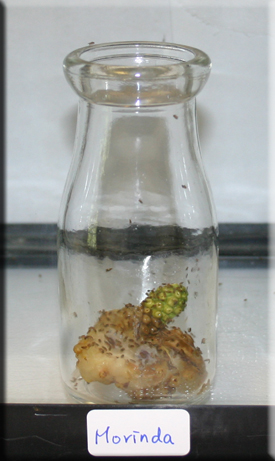
Research on Adaptation
Surprisingly little is known about the genetics of adaptations in complex eukaryotes, for example: what types of genes change, how do they change, and where do adaptive alleles come from? The absence of answers to these questions is particularly noted in behavioral fields, despite the importance of behavioral adaptations in nature and their impact on human health and well-being.
Across the insect world, adaptations to strong host preference are relatively abundant. Within the world of Drosophila, there are two known instances of this occurrence. Drosophila sechellia is one of the best characterized. Given the choice, D. sechellia will make sole use of the fruit of the Morinda plant (Morinda citrifolia) over any other available food. Genetic causes for this unique behavior are traced back changes in odor perception, a trait linked to the olfactory and gustatory sensors.
occurrence. Drosophila sechellia is one of the best characterized. Given the choice, D. sechellia will make sole use of the fruit of the Morinda plant (Morinda citrifolia) over any other available food. Genetic causes for this unique behavior are traced back changes in odor perception, a trait linked to the olfactory and gustatory sensors.
So far, we have collaboratively identified the genes underlying these olfactory and gustatory preferences. But we have also found that these genes are not sufficient to explain D. sechellia's behavior.
The primary goal of this area of our research is to identify all of the major genes underlying D. sechellia’s host preference and to characterize their functional role. We have already found several candidate loci awaiting further investigation. During that process however, we discovered that the recently completed D. sechellia reference genome is fraught with errors. These errors significantly reduce the utility of this genome for identifying candidate genes. For that reason, we have resequenced the D. sechellia genome using new high throughput whole genome sequencing technologies and have made an initial reassembly of the reference. This will ensure that our secondary goals are carried out with the highest accuracy possible.
Our first goal is to use the new reference sequence and previous gene expression data to complete our screen for chemo-perception loci with structural changes or expression patterns distinct to D. sechellia. We will then combine these data with genetic data produced by two complimentary high-throughput genetic mapping methods. From these data we will have a list of genes implicated in preference, estimates of their relative importance to preference, and a first approximation of how these loci interact with each other.
Our second goal focuses on functionally testing the genes uncovered in our first goal. We will use cell-specific ablations of components of the olfactory and gustatory systems of D. melanogaster to learn how these components affect perception of D. sechellia’s host plant. We will then test candidate loci—individually and in combination—using RNA interference.
We will begin our third goal by investigating non-chemosensory loci using RNA interference. Using a combination of engineered zinc-finger nucleases and transgenics, we will confirm our RNA interference findings and test “gain-of-function” alleles.
The data we seek to uncover will provide a uniquely in-depth view of how a genetically complex behavior evolves. It will also provide a springboard for further studies of adaptation involving host preference. This last quality is particularly important as the number of insect disease vectors adaptively shifting from zoophily to anthropophily rises.
This research will be primarily conducted by PhD candidate Eric Earley, in fulfillment of his thesis requirements.

